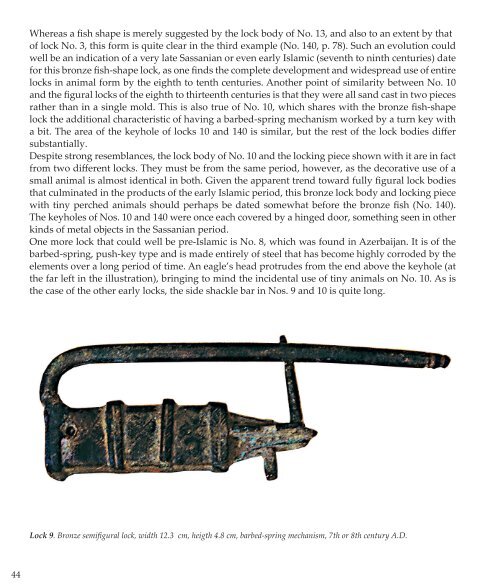Persian Locks: 1500 Years of Iranian Padlocks
In Iran, the padlock was developed in an amazing variety of sizes, shapes, materials, and mechanisms, the likes of which are less frequently encountered in Europe. On the whole, very little attention has been devoted to the history and development of the lock in Iran. Parviz Tanavoli, Iran's leading sculptor, was first attracted to the locks of his own country because of their sculptural qualities. In this beautiful and informative book the author shares with us, in over 500 photos and drawings, the most interesting examples of locks from his famous collection which was first introduced to the American public by the Smithsonian Institute on the occasion of the American Bicentennial. You will also find detailed drawings which clearly illustrate the workings of the various locking mechanisms (e.g., barbed-spring, helical-spring, notched-shackle, hook and revolving catch, etc.) used in the locks in this book. All locks are dated and when known, the place of manufacture is given. A smaller version of this updated and expanded book was published by The Smithsonian Institution in 1976 with the title, "Locks from Iran: Pre-Islamic to Twentieth Century." In 2019 and 2020 the author edited his original book adding new text and a great number of new high-quality photos of locks which have been added to his collection in the 44 years since the first book was published. Hardcover, 144 pages, 10-inches x 8.5-inches, over 500 photos and drawings.
In Iran, the padlock was developed in an amazing variety of sizes, shapes, materials, and mechanisms, the likes of which are less frequently encountered in Europe. On the whole, very little attention has been devoted to the history and development of the lock in Iran.
Parviz Tanavoli, Iran's leading sculptor, was first attracted to the locks of his own country because of their sculptural qualities. In this beautiful and informative book the author shares with us, in over 500 photos and drawings, the most interesting examples of locks from his famous collection which was first introduced to the American public by the Smithsonian Institute on the occasion of the American Bicentennial. You will also find detailed drawings which clearly illustrate the workings of the various locking mechanisms (e.g., barbed-spring, helical-spring, notched-shackle, hook and revolving catch, etc.) used in the locks in this book. All locks are dated and when known, the place of manufacture is given.
A smaller version of this updated and expanded book was published by The Smithsonian Institution in 1976 with the title, "Locks from Iran: Pre-Islamic to Twentieth Century." In 2019 and 2020 the author edited his original book adding new text and a great number of new high-quality photos of locks which have been added to his collection in the 44 years since the first book was published.
Hardcover, 144 pages, 10-inches x 8.5-inches, over 500 photos and drawings.
You also want an ePaper? Increase the reach of your titles
YUMPU automatically turns print PDFs into web optimized ePapers that Google loves.
Whereas a fish shape is merely suggested by the lock body <strong>of</strong> No. 13, and also to an extent by that<br />
<strong>of</strong> lock No. 3, this form is quite clear in the third example (No. 140, p. 78). Such an evolution could<br />
well be an indication <strong>of</strong> a very late Sassanian or even early Islamic (seventh to ninth centuries) date<br />
for this bronze fish-shape lock, as one finds the complete development and widespread use <strong>of</strong> entire<br />
locks in animal form by the eighth to tenth centuries. Another point <strong>of</strong> similarity between No. 10<br />
and the figural locks <strong>of</strong> the eighth to thirteenth centuries is that they were all sand cast in two pieces<br />
rather than in a single mold. This is also true <strong>of</strong> No. 10, which shares with the bronze fish-shape<br />
lock the additional characteristic <strong>of</strong> having a barbed-spring mechanism worked by a turn key with<br />
a bit. The area <strong>of</strong> the keyhole <strong>of</strong> locks 10 and 140 is similar, but the rest <strong>of</strong> the lock bodies differ<br />
substantially.<br />
Despite strong resemblances, the lock body <strong>of</strong> No. 10 and the locking piece shown with it are in fact<br />
from two different locks. They must be from the same period, however, as the decorative use <strong>of</strong> a<br />
small animal is almost identical in both. Given the apparent trend toward fully figural lock bodies<br />
that culminated in the products <strong>of</strong> the early Islamic period, this bronze lock body and locking piece<br />
with tiny perched animals should perhaps be dated somewhat before the bronze fish (No. 140).<br />
The keyholes <strong>of</strong> Nos. 10 and 140 were once each covered by a hinged door, something seen in other<br />
kinds <strong>of</strong> metal objects in the Sassanian period.<br />
One more lock that could well be pre-Islamic is No. 8, which was found in Azerbaijan. It is <strong>of</strong> the<br />
barbed-spring, push-key type and is made entirely <strong>of</strong> steel that has become highly corroded by the<br />
elements over a long period <strong>of</strong> time. An eagle’s head protrudes from the end above the keyhole (at<br />
the far left in the illustration), bringing to mind the incidental use <strong>of</strong> tiny animals on No. 10. As is<br />
the case <strong>of</strong> the other early locks, the side shackle bar in Nos. 9 and 10 is quite long.<br />
Lock 9. Bronze semifigural lock, width 12.3 cm, heigth 4.8 cm, barbed-spring mechanism, 7th or 8th century A.D.<br />
44










